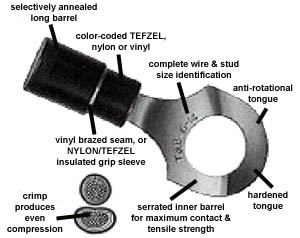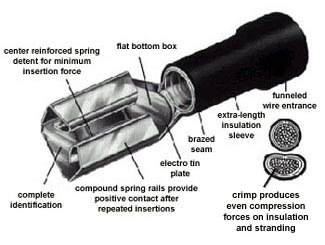Thomas & Betts Products
|
Sta-Kon |
|
Why Sta-Kon
Terminals & |
 |
| Chamfered/Funneled Terminal Barrel Entry |
| This feature makes wire insertion
faster annd easier. Chamfering eliminates wire strand "hang-up" and departure upon insertion into the terminal's barrel. The loss of even a couple of wire strands can have negative results on electrical efficiency and resistance to mechanical strain. |
| Deep Internal Serrations |
| After the insertion of a wire into
the terminal's barrel, a deep serrated interior insures a large area of contact which lowers the resistance of a connection. Upon the mechanical force of tool-applied pressure, the wire strands cold flow into the serrated interior. This guarantees electrical resistance lower than the wire to which it is applied. This feature also prevents pullout from vibration and mechanical strain. Deep internal serrations can be compared to the effective holding power of a well treaded tire on a wet highway. |
| Sta-Kon's Long Barrel Design |
| If lowering electrical resistance,
preventing wire pullout, eliminating a "missed" crimp, and an insulator that stays on the barrel during installation are your goals, then you need a terminal with a long barrel. The fact is that most competitive barrel lengths range from 20%-50% shorter than the Sta-Kon. The results of these shorter lengths are usually a stream of electrical failure, rework, lost insulators and added expense. But with the Sta-Kon, the additional length provides the insulator with additional surface area for holding tight to the barrel. |
| Anti-Rotational Tongues |
| This is a unique feature to the
Thomas & Betts ring tongue terminal. This design prevents terminal shorting by keeping the terminal secure in the terminal block. The installer can place a greater number of terminals closer together without worry. |
| Brazed or Overlapped Seam |
| A long barrel design is of little
value unless it is one solid piece. That is why Thomas & Betts brazes the seam on their vinyl insulated Sta-Kon and overlaps the seam on nylon insulated terminals. Many competitive terminals have butted seams. This means increased chances for wirestrand loss, poor resistance, wire pullout and electrical failure. If the installer doesn't position the tool exactly on the correct spot on the barrel, there's a likely chance of an improper termination. The butted seam can also fold due to tool-applied pressure piercing the terminals insulation from the inside out. With a brazed or overlapped seam the installer can crimp anywhere along the barrel's surface providing up to 21/2 times the tensile strength of a butted seam terminal, guaranteeing proper electrical flow, void free. |
| Underwriters Laboratories Listing |
| Sta-Kon Rings, Fork, and Locking
Forks are tested and listed to U.L. 486A, two-way splices to U.L. 486C, disconnects to U.L. 310 and all applicable products to CSA 22.2. |
| Selective Annealing |
| Because of the mechanical strength
of copper, an installer can experience fatigue associated with repeated installations. For this reason Thomas & Betts puts our terminals through one more step called selective annealing. This process leaves the barrel soft enough to crimp and form around the wire. However, we "cold form" the tongue during the manufacturing process so it remains strong. This is done so the tongue can withstand repeated bends and bolt tightening strain common in most electrical installations. Many competitors attempt to accomplish similar goals by removing valuable material or using a softer copper which has lower conductivity. This increases electrical resistance as well as the odds for shorting and downtime. |
| Proper Identification |
| Thomas & Betts identifies all
terminals with its initials, T & B. The terminals also indicate wire and stud sizes. These markings are clearly visible on the surface of the tongue, taking any guesswork out of replacing or reordering additional parts. Thomas & Betts' superior bright plating also assists in visibility. |
| All Sta-Kon Terminals are Deburred and Degreased |
| To insure a Sta-Kon terminal is
properly plated and insulated, all parts are put through a process which cleans and smooths the terminal of any manufacturing by-products, mainly grease, oils and sharp edges. Many competitors do not put their product through such rigorous finishing. |

|
|
To find out more about
Sta-Kon or |